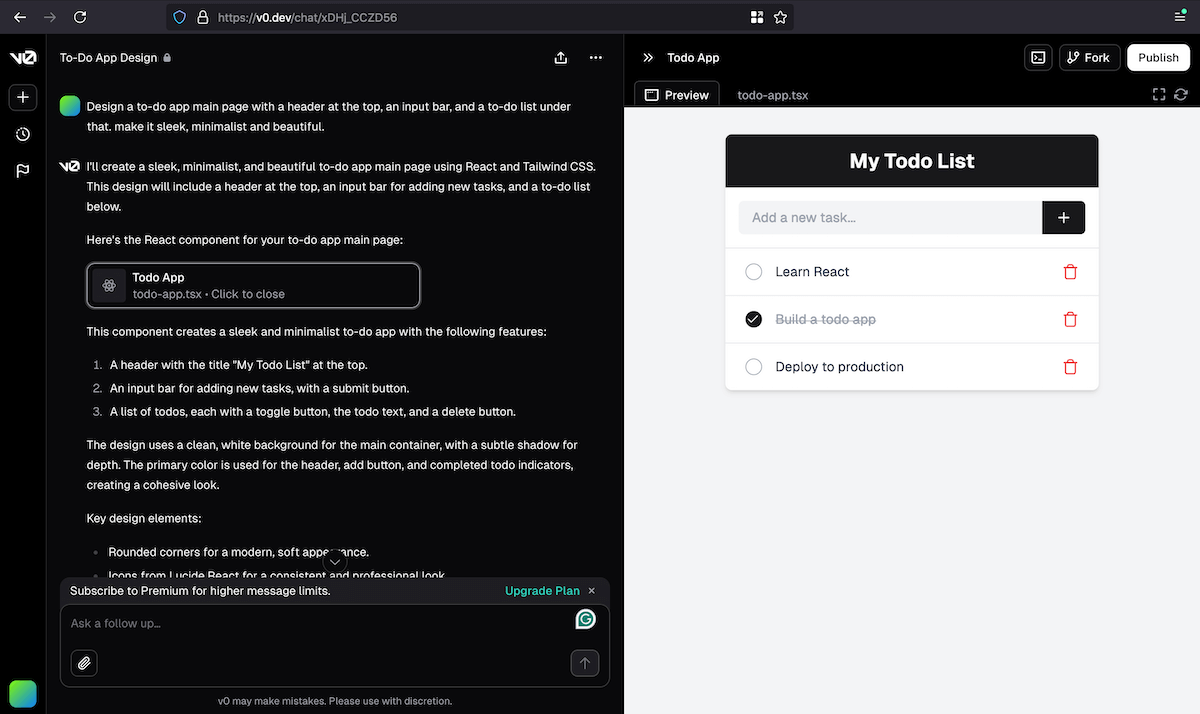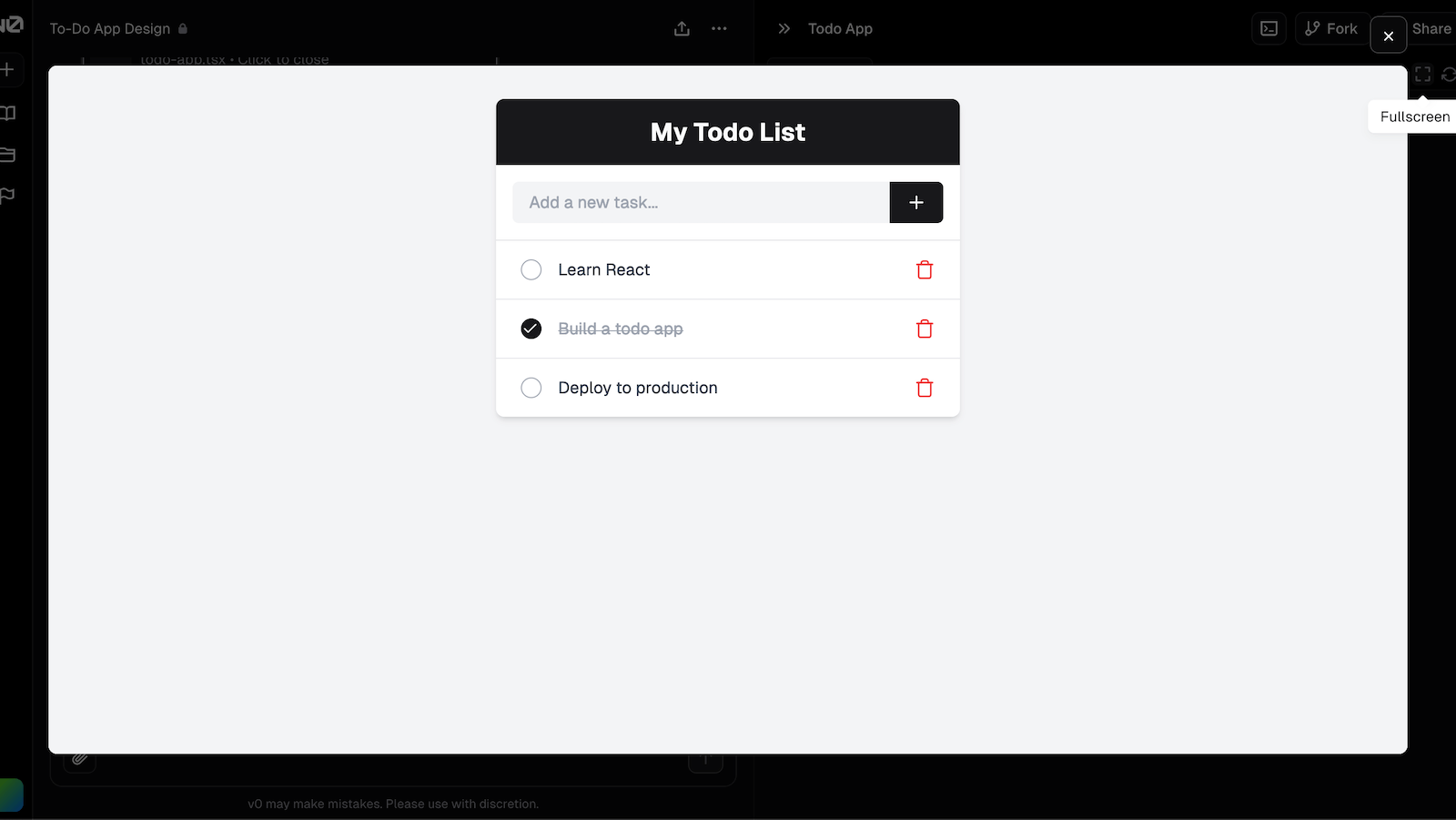Introduction
Hey everyone!
After building the backend of my to-do app with Go (if you missed it, you can catch up here), It's time to bring the frontend to life.
I wanted to try something new, so I used Vercel's v0.dev/chat to generate the initial design. It turned out to be a pretty smooth experience (which is never the case for me 😂), So I want to share how it all came together.
Quick Recap
Just to recap, I previously built a simple RESTful API using Go, Gin, and GORM, connected to a PostgreSQL database. I deployed it on Fly.io, and it's ready to serve data to our frontend.
Now, I wanted to build a modern frontend using Next.js 14 with TypeScript and Tailwind CSS, utilizing the new Next.js App Router. Let's dive into how I did it.
Generating the Frontend Design with v0.dev

Generate UI with shadcn/ui from simple text prompts and images.
I came across v0.dev, an AI tool from Vercel that helps generate UI code. And this one is particularly intersting becuase this app Generates UI's with shadcn/ui.
I thought it might save me some time and give me a fresh perspective, so I gave it a shot.
v0.dev Prompt & Generation
This was my actual prompt:
"Design a to-do app main page with a header at the top, an input bar, and a to-do list under that. make it sleek, minimalist and beautiful"
The result? A pretty decent starting point:

v0.dev generated the initial code for me, which was a great starting point, but obviously I needed to make some adjustments to fit my needs:
- Updated the styling to match my preferences.
- Ensured the components were using TypeScript properly.
- Adjusted the layout for responsiveness and accessibility.
Building the Frontend
- Setting Up the Next.js Project
I created a new Next.js project with TypeScript support, inside the a "frontend" folder:
npx create-next-app@latest go-frontend --typescript
cd go-frontendCreating the Components
- AddTodo Component
This component lets users add new tasks.
// components/AddTodo.tsx
'use client';
import React, { useState } from 'react';
interface AddTodoProps {
onAdd: (title: string) => void;
}
const AddTodo: React.FC<AddTodoProps> = ({ onAdd }) => {
const [title, setTitle] = useState('');
const handleSubmit = (e: React.FormEvent) => {
e.preventDefault();
if (title.trim()) {
onAdd(title);
setTitle('');
}
};
return (
<form onSubmit={handleSubmit} className="flex my-4">
<input
type="text"
placeholder="Add a new task"
value={title}
onChange={(e)=> setTitle(e.target.value)}
className="flex-grow p-2 border rounded-l"
/>
<button type="submit" className="p-2 bg-blue-500 text-white rounded-r">
Add
</button>
</form>
);
};
export default AddTodo;- TodoItem Component
Displays each task with options to edit, complete, or delete.
// components/TodoItem.tsx
'use client';
import React, { useState } from 'react';
interface TodoItemProps {
id: number;
title: string;
completed: boolean;
onToggle: (id: number) => void;
onDelete: (id: number) => void;
onEdit: (id: number, title: string) => void;
}
const TodoItem: React.FC<TodoItemProps> = ({
id,
title,
completed,
onToggle,
onDelete,
onEdit,
}) => {
const [isEditing, setIsEditing] = useState(false);
const [newTitle, setNewTitle] = useState(title);
const handleEdit = () => {
if (isEditing && newTitle.trim() !== title) {
onEdit(id, newTitle);
}
setIsEditing(!isEditing);
};
return (
<li className="flex items-center justify-between py-2">
<div className="flex items-center">
<input
type="checkbox"
checked={completed}
onChange={()=> onToggle(id)}
className="mr-2"
/>
{isEditing ? (
<input
type="text"
value={newTitle}
onChange={(e)=> setNewTitle(e.target.value)}
className="border px-2 py-1"
/>
) : (
<span className={completed ? 'line-through text-gray-500' : ''}>
{title}
</span>
)}
</div>
<div>
<button onClick={handleEdit} className="text-blue-500 hover:underline mr-2">
{isEditing ? 'Save' : 'Edit'}
</button>
<button onClick={()=> onDelete(id)} className="text-red-500 hover:underline">
Delete
</button>
</div>
</li>
);
};
export default TodoItem;- TodoList Component
Brings everything together.
// components/TodoList.tsx
'use client';
import React, { useEffect, useState } from 'react';
import AddTodo from './AddTodo';
import TodoItem from './TodoItem';
interface Todo {
id: number;
title: string;
completed: boolean;
}
const TodoList: React.FC = () => {
const [todos, setTodos] = useState<Todo[]>([]);
const [loading, setLoading] = useState(true);
const [showCompleted, setShowCompleted] = useState(true);
const fetchTodos = async () => {
try {
const res = await fetch(`${process.env.NEXT_PUBLIC_BACKEND_URL}/todos`);
const data = await res.json();
setTodos(data);
} catch (error) {
console.error('Error fetching todos:', error);
} finally {
setLoading(false);
}
};
useEffect(() => {
fetchTodos();
}, []);
const addTodo = async (title: string) => {
// ...code to add todo
};
const toggleTodo = async (id: number) => {
// ...code to toggle todo
};
const editTodo = async (id: number, title: string) => {
// ...code to edit todo
};
const deleteTodo = async (id: number) => {
// ...code to delete todo
};
const currentTasks = todos.filter((todo) => !todo.completed);
const completedTasks = todos.filter((todo) => todo.completed);
return (
<div>
<AddTodo onAdd={addTodo} />
{loading ? (
<p>Loading...</p>
) : (
<>
{/* Current Tasks */}
{currentTasks.length > 0 && (
<div>
<h2>Current Tasks</h2>
<ul>
{currentTasks.map((todo) => (
<TodoItem
key={todo.id}
{...todo}
onToggle={toggleTodo}
onDelete={deleteTodo}
onEdit={editTodo}
/>
))}
</ul>
</div>
)}
{/* Completed Tasks */}
{completedTasks.length > 0 && (
<div>
<h2>
Completed Tasks
<button onClick={()=> setShowCompleted(!showCompleted)}>
{showCompleted ? 'Hide' : 'Show'}
</button>
</h2>
{showCompleted && (
<ul>
{completedTasks.map((todo) => (
<TodoItem
key={todo.id}
{...todo}
onToggle={toggleTodo}
onDelete={deleteTodo}
onEdit={editTodo}
/>
))}
</ul>
)}
</div>
)}
</>
)}
</div>
);
};
export default TodoList;- Main Page.
Updated app/page.tsx to render the TodoList:
// app/page.tsx
import React from 'react';
import TodoList from '../components/TodoList';
const HomePage: React.FC = () => (
<main className="container mx-auto p-4">
<TodoList />
</main>
);
export default HomePage;Integrating with Our Go Backend on Fly.io
Remember our backend deployed on Fly.io? Time to make our frontend and backend BFFs.
- Setting the Backend URL
In .env.local:
NEXT_PUBLIC_BACKEND_URL=https://your-backend.fly.dev
- Handling CORS on the Backend
Our frontend needs permission to talk to the backend.
Updated the Go backend's CORS configuration:
import (
// ...other imports
"github.com/gin-contrib/cors"
)
func main() {
// ...previous code
router := gin.Default()
router.Use(cors.New(cors.Config{
AllowOrigins: []string{"https://your-frontend.vercel.app"},
AllowMethods: []string{"GET", "POST", "PUT", "DELETE"},
AllowHeaders: []string{"Origin", "Content-Type", "Accept"},
}))
// ...rest of the code
}Deploying the Frontend on Vercel
- Logged into Vercel and imported the GitHub repository.
- Set up the environment variable NEXT_PUBLIC_BACKEND_URL.
- Hit deploy and watched the magic happen! ✨
Things To Keep In Mind
AI Generation: AI can be fun, but it can also make obvious dumb mistakes. It is helpful, but you make the final call, don't forget that.
CORS: Cross-origin requests can be a headache. Ensure both your frontend and backend are configured correctly to communicate.
And there you have it! We now have a fully functional to-do app with a Go backend and a Next.js frontend, all tied together with some AI-designed flair. Not too shabby, huh?
Final Thoughts

This project was a blast. Combining Go, Next.js, and AI design tools opened up new horizons for me. If you're considering a similar project, go for it! And don't be afraid to let AI lend a hand—it might just surprise you.
Feel free to check out the repositories:
- Backend GitHub Repo
- Frontend Repo
